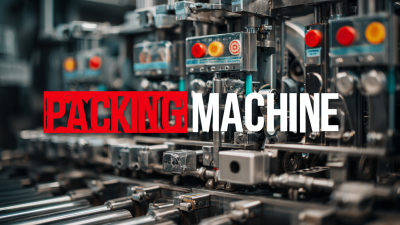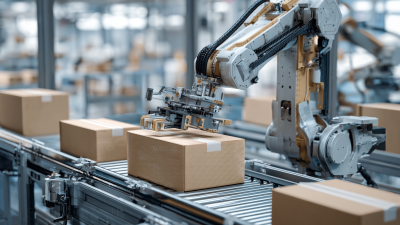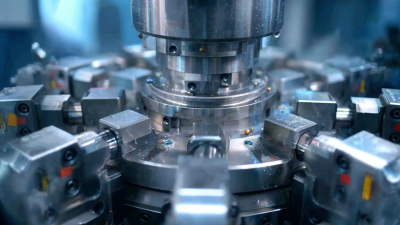How to Optimize Your Production Efficiency with Industrial Packing Machines
In the rapidly evolving landscape of manufacturing, optimizing production efficiency is paramount for businesses seeking to maintain competitive advantage. According to a recent report by MarketsandMarkets, the global industrial packing machine market is projected to reach $45.8 billion by 2025, reflecting a compound annual growth rate (CAGR) of 5.3% between 2020 and 2025. As industries increasingly emphasize automation and speed, the integration of advanced Industrial Packing Machines becomes essential. These machines not only enhance throughput but also guarantee consistency and reduce labor costs, making them indispensable assets in modern production lines. By leveraging state-of-the-art technology in industrial packing, companies can streamline their operations and improve overall productivity, ultimately leading to higher profitability and market share.

Understanding the Role of Industrial Packing Machines in Modern Manufacturing Efficiency
Industrial packing machines play a pivotal role in optimizing manufacturing efficiency within the ever-evolving landscape of Industry 4.0. As manufacturers increasingly adopt smart technology, the integration of these machines becomes crucial. Research indicates that the global vacuum packing machines market was valued at approximately USD 4.9 billion in 2024 and is projected to grow at a compound annual growth rate (CAGR) of 5.1% between 2025 and 2034. This underscores the significant investment and reliance on advanced packing solutions, which not only streamline processes but also reduce waste and enhance product integrity.
Furthermore, with the increasing shift towards automation and digitization, the end-of-line (EOL) packaging market is set for significant growth. Innovations in EOL packaging—such as robotics and artificial intelligence—enhance production capabilities, allowing manufacturers to perform complex tasks more efficiently. By addressing these technological advancements, industries can transform their packing stages to ensure faster turnaround times and improved adaptability to market demands, ultimately leading to enhanced overall productivity within manufacturing operations.
Production Efficiency Optimization with Industrial Packing Machines
Key Types of Industrial Packing Machines and Their Specific Advantages
Industrial packing machines play a crucial role in enhancing production efficiency across various sectors. Among the key types of these machines, automatic packing systems stand out due to their ability to significantly reduce labor costs and increase speed. According to a report by Grand View Research, the global market for automated packing machines is expected to reach $55.05 billion by 2025, driven by the need for streamlined operations and higher throughput. These machines can operate continuously and adapt to various product dimensions, thereby minimizing downtime and maximizing output.

Another essential type of industrial packing machine is the robotic packing system. These systems not only automate the packing process but also ensure consistent quality and reduce the risk of product damage. A study from the International Federation of Robotics indicated that the use of robotics in packaging has increased by over 30% in recent years, demonstrating a shift towards automation in the industry. Robotic systems are particularly advantageous in high-volume environments where speed and precision are paramount, making them an excellent choice for manufacturers looking to optimize their production efficiency.
Recent Industry Data on Productivity Gains from Automated Packing Solutions
Recent industry data reveals that automated packing solutions significantly enhance production efficiency, with productivity gains reported at an impressive rate of 20-30% across various sectors. According to a study by the Automated Packaging Association, companies that have integrated industrial packing machines into their workflows have seen a decrease in labor costs by approximately 15%, thanks to reduced manual handling and increased throughput. These machines streamline packaging processes, allowing manufacturers to fulfill orders more swiftly and accurately, ultimately improving their bottom line.
**Tips:** To maximize the benefits of industrial packing machines, consider conducting a thorough needs assessment to identify the specific requirements of your production line. This will help in selecting the right machinery that aligns with your operational goals. Additionally, regularly training staff on best practices for operating these machines can further optimize efficiency and minimize downtime.
Incorporating real-time data monitoring systems can also enhance productivity. A report from the Packaging Machinery Manufacturers Institute indicates that businesses utilizing smart packing technologies have experienced a further reduction in errors and waste by nearly 25%. Leveraging these advanced analytics can lead to more informed decision-making and continuous improvement in production efficiency.

Evaluating Cost Savings: How Packing Machines Reduce Waste and Labor Costs
Industrial packing machines play a crucial role in optimizing production efficiency by significantly reducing waste and labor costs. According to a report by the Freedonia Group, businesses can expect to see a reduction in packaging waste by up to 30% when incorporating automated packing solutions. This reduction not only decreases material costs but also minimizes the environmental impact, allowing companies to showcase their commitment to sustainability.
Moreover, labor costs can be dramatically lowered through the use of packing machines. The Bureau of Labor Statistics indicates that automation in the packaging sector can result in an average labor cost savings of 40%. With machines handling repetitive tasks, workers can focus on more value-added processes, enhancing overall productivity. As industries increasingly adopt these technologies, the reduction in manual handling not only streamlines operations but also helps in mitigating human errors, leading to further savings in both time and resources.
Future Trends in Industrial Packing Technologies and Their Impact on Efficiency
The future of industrial packing technologies is increasingly focused on combining efficiency with sustainability, particularly in the food and pharmaceutical sectors. As highlighted in a recent industry report, the global paper packaging market, driven by the demand for eco-friendly solutions, is projected to continue its upward trajectory, with the Southeast Asian region, notably Indonesia, taking a central role in this transformation. By 2025, the region is expected to significantly contribute to a market valued at approximately $264 billion for pulp, with a compound annual growth rate of around 2.5%.
Moreover, the automation of packing processes is gaining momentum. The automated palletizing market, for example, is estimated to grow from $758 million in 2023 to $1.15 billion by 2031, reflecting a compound annual growth rate of 4.77%. This trend underscores how companies are leveraging advanced technologies not only to boost productivity but also to align with environmental regulations and consumer preferences for sustainable practices. Thus, the integration of innovative packing machines is essential for industries aiming to optimize production efficiency while adhering to an increasingly green future.
Related Posts
-

What is the Best Packing Machine for Your Business Needs in 2023
-

Exploring Innovative Alternatives to the Best Industrial Packing Machine
-

Unveiling the 2025 Tech Trends: How the Best Industrial Packing Machines are Redefining Efficiency
-

China's Pinnacle of Excellence: The Unmatched Best Machine Repairing Machine for Global Buyers
-

5 Reasons Why Best Parts Machine is the Ultimate Choice for Global Buyers
-

Top Strategies for Sourcing Essential Parts Of Industrial Machine
